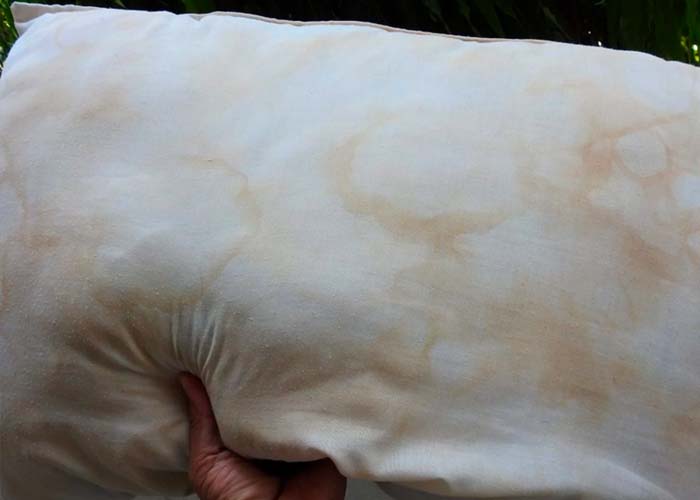Pillows are one of those household products that no matter how hard you try, they always seem to get dirty. If you have ever had a pillow turn yellow, then this blog post is for you! We will be discussing 15 reasons why pillows turn yellow and what can be done about it.
And we will touch on pillowcases because often, they absorb the dirt and oil on your skin, which then transfers to the pillow. Dust mites are also attracted to these oils, making them breed faster, leading to an increase in allergies for you or anyone else around the pillows.
Below are the reasons and solutions that stop your best pillows from turning into a mess.
Causes and Solutions
- Excessive Sweating During Sleep
You sweat during the night because your body is at its warmest while you are sleeping. Your head is the warmest part of your body which can make your pillow hot, and if the pillowcase does not breathe, the airflow through to your skin becomes moist. Because of this sweat, bacteria will start to grow, leading to foul odours and even stains on the pillow.
Solution: If you want to reduce sweating during sleep or if you have allergies, consider switching out your current cases with silk pillowcases! They are great at keeping the oils away from sleeping on them and also help to reduce sweat during sleep.
You can also try switching out your pillowcase more frequently. Consider using a satin sleep mask to protect the oils from getting onto your face and into your hair. You can also try using a pillowcase made from bamboo or silk to keep the oils away.
- Oily Skin and Hair
If you have oily hair or skin, your pillow likely accumulates oils from these. If this is the case, you may want to consider switching out your pillows more often than usual, so they don’t become stained and yellowed by your oil buildup.
- Dry Skin and Hair
Dry your hair before going to bed. This will help reduce the number of oils that get transferred from your head onto the pillow, making it turn yellow over time. Try using a body powder (talcum powder or baby powder) to reduce the amount of sweat produced during sleep.
- Fitted sheets
If you have fitted sheets, this can lead to more sweat and dirt being absorbed by your pillows. You may want to consider changing them every once in a while so that it doesn’t transfer onto your pillows as well as reducing the amount of dust build-up on the sheet itself.
- How Often You Wash Your Sheets
If you aren’t washing your bedding often enough, this could be another reason your pillows are turning yellow. You should wash them at least once every two weeks to keep the oils and dirt away! If you don’t want to do it yourself, consider getting a housekeeper or hiring someone else to help out with this task for you.
- What Type of Sheets You Have
If you have cotton sheets, then this can lead to more sweat and dirt being absorbed by your pillows. You may want to consider changing them every once in a while so that it doesn’t transfer onto your pillows as well as reducing the amount of dust build-up on the sheet itself.
You can also look into bamboo sheets or other naturally hypoallergenic sheets.
- Sleeping Face Down on the Pillow
If you sleep on your face, then it’s possible that oils from your skin may transfer to the pillow. This can lead to a build-up of dirt and oil, which could cause stains and make your pillows turn yellow.
Solution: Consider using a silk or satin pillowcase to have less friction between your skin and the pillow. If you aren’t a fan of these kinds of cases, then consider using a cotton case that breathes better so less sweat is accumulated on your pillows over time.
You should also try not to sleep face down too often as it causes more pressure onto the pillow, leading to wrinkles in the fabric over time!
- Using Hot Water
Hot water can cause the fibres of your pillow to wear down faster, which in turn will decrease how long it lasts. Try using cold or lukewarm water when washing pillows to help with extending their lives. You should also consider washing them less frequently if you notice that they are starting to get a yellow tint.
- Using the Wrong Detergent
Pillows should be washed with mild detergents that are specifically made for washing pillows, like this one. If you use too harsh soap or cleaner on your pillow, it can cause discolouration and, in some cases, damage to the fibres inside. You also want to make sure that you are using the correct amount of detergent. If your pillow is not getting clean enough, try adding a little more detergent to see if that helps.
- Overloading Your Washer
If you have a large capacity washer, it’s essential to make sure that you don’t overload it with pillows or any other items. This will cut down on the number of times you have to run a load, and it can prevent your pillows from getting damaged or not completely clean when they come out of the washer.
If you want to do the job right, check out our guide on how to clean your pillow.
- Using Bleach
It is important to make sure that you are using bleach sparingly with your pillows because it can cause the filling to deteriorate over time. If you notice that your pillows are turning yellow faster than usual, it may be because you are using too much bleach in your wash routine.
- Not Washing Your Pillowcase
If you don’t remember when was the last time that you washed your pillowcases, chances are it’s time to wash them. Pillowcases that aren’t washed can also transfer oils and dirt onto your pillows which is one of the leading causes of turning yellow over time.
You should wash them at least once every two weeks to keep the oils and dirt away! Additionally, if you notice many allergies around your pillows, consider using a more breathable pillowcase that does not allow for as much dust to build up.
- The Fabric Softener You Use
Using fabric softeners on your pillowcases or sheets can cause problems because it causes the fibres to break down. Fabric softeners are also bad for pillows because they can cause mould and mildew, which will make your pillow smell like sweat or not fresh at all.
- Storing Them in Plastic Bags
You should never store your pillows in plastic bags as this is a breeding ground for dust mites. You can also prevent your pillows from getting yellowed out by keeping them in the open air to allow airflow and keep dust mites at bay.
- Using Dryer Sheets
Dryer sheets are not recommended for use on your pillow because it leaves a residue that will lead to problems over time. Instead, try using a dryer ball or even just a cotton cloth to help soften clothes and reduce wrinkles.
Conclusion
Above are a few tactics to stop your pillows from turning yellow and why it might be happening. The main cause is oil and dirt build-up from use that transfers from your pillowcase to your pillow.
Also, we didn’t mention it, but you can try vacuum cleaning your pillows regularly to remove any buildup of dust or dirt. If you are unsure how often to do this, then read the label on your pillow for specific instructions!
For more tips and tricks like these, make sure to check out our other blogs that will help you with everything home-related!

 Nectar Mattress
Nectar Mattress 


